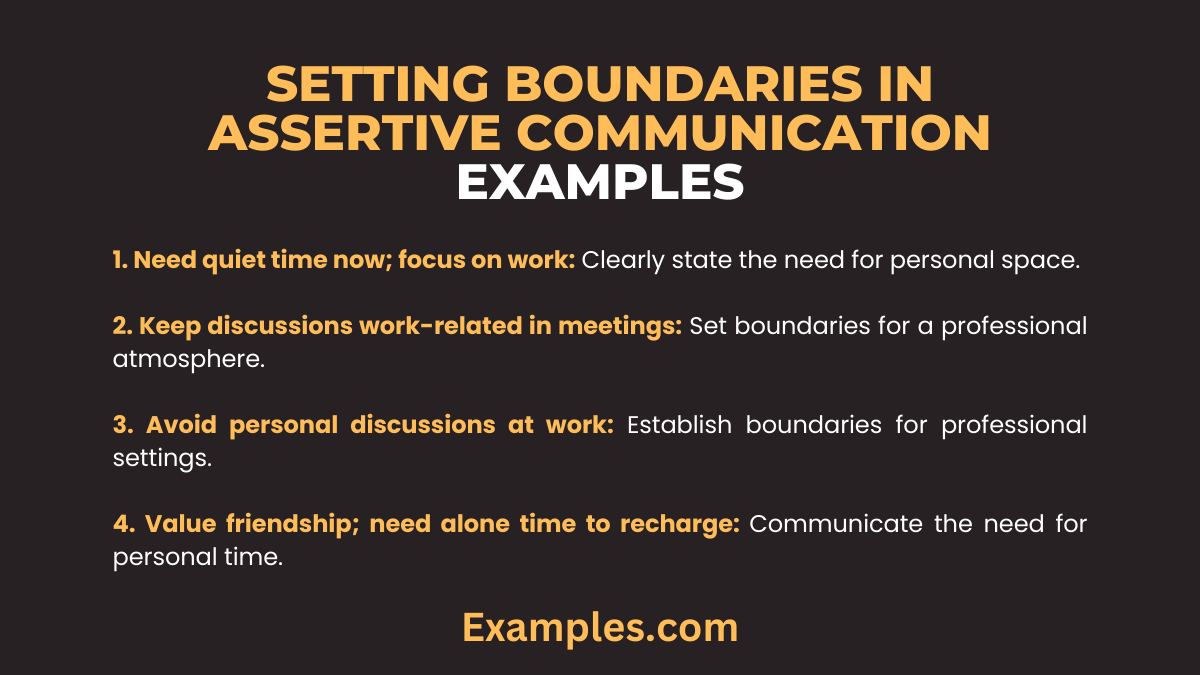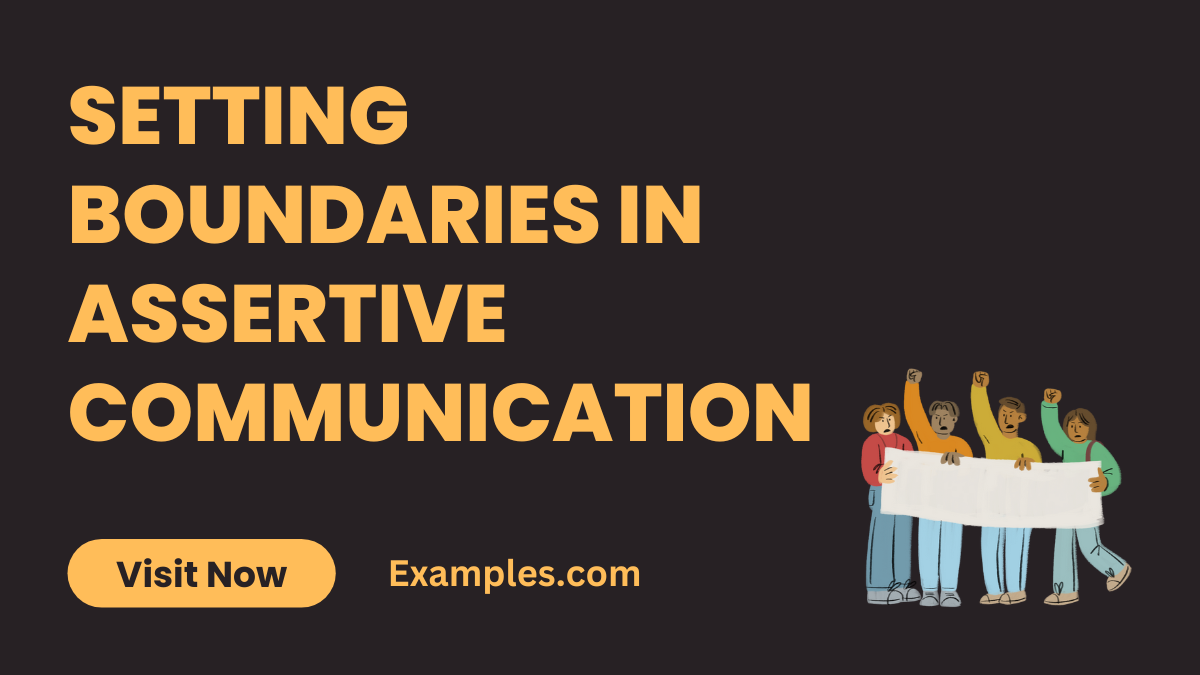14+ Setting Boundaries in Assertive Communication Examples
Establishing clear boundaries is a crucial aspect of oral communication, particularly in assertive interactions. Boundaries help create a respectful and effective communication environment. This involves actively communicating personal limits and expectations, ensuring that interactions remain constructive and mutually beneficial. When incorporating assertiveness, understanding the balance between expressing needs and respecting others’ boundaries enhances overall communication dynamics. Mastering this skill is essential for fostering healthy relationships and achieving successful outcomes in various interpersonal scenarios.
Setting Boundaries in Assertive Communication Examples

- “I appreciate your enthusiasm, but I need some quiet time now to focus on my work.” Clearly state the need for personal space and time.
- “Let’s keep our discussions focused on work-related matters during business meetings.” Set boundaries to maintain a professional atmosphere.
- “I prefer not to discuss my personal life at work; let’s keep our conversations work-related.” Establish boundaries regarding personal topics in a professional setting.
- “I value our friendship, but I need some time alone tonight to recharge.” Communicate the need for personal time within friendships.
- “I’m open to feedback, but please share it in a constructive manner.” Set boundaries for constructive criticism in communication.
- “I won’t tolerate disrespectful language in our conversations; let’s maintain a respectful tone.” Establish boundaries for respectful communication.
- “I appreciate your concern, but I’d like to make decisions about my life independently.” Clearly express the desire for autonomy in decision-making.
- “Please avoid commenting on my appearance; let’s focus on the task at hand.” Set boundaries regarding personal comments in a professional context.
- “Let’s refrain from discussing sensitive topics during family gatherings to maintain a positive atmosphere.” Establish boundaries for family interactions to foster harmony.
- “I need at least 24 hours’ notice for any last-minute changes to our plans.” Communicate expectations regarding schedule changes.
- “I value our friendship, but I need some space right now to deal with personal challenges.” Clearly communicate the need for space during challenging times.
- “I’m comfortable sharing my opinion, but let’s avoid interrupting each other during discussions.” Set boundaries for respectful and uninterrupted communication.
- “I prefer not to lend money to friends; let’s find other ways to support each other.” Establish financial boundaries to avoid conflicts.
- “I appreciate your concern, but I’d like to handle this matter on my own for now.” Clearly express the desire for autonomy in addressing personal matters.
- “I’m willing to help, but I can only commit to specific tasks within the given timeframe.” Communicate limitations and expectations when offering assistance
How to Be Assertive and Set Healthy Boundaries?
Mastering assertiveness in oral communication involves effectively expressing your needs while respecting others’ boundaries. Follow these steps to cultivate assertive communication and establish healthy boundaries in various interpersonal situations:
- Understand Your Rights: Recognize your right to express opinions, say no, and set limits. Assertiveness begins with acknowledging and valuing your needs in communication.
- Practice Active Listening: Engage in attentive listening to understand others’ perspectives. Active listening fosters empathy, essential for assertive communication.
- Know Your Values and Priorities: Clearly define your values and priorities. This clarity empowers you to communicate assertively and set boundaries aligned with your principles.
- Use “I” Statements: Express your thoughts and feelings using “I” statements, focusing on personal experiences without placing blame. This promotes open communication.
- Be Clear and Concise: Articulate your thoughts clearly and concisely. Avoid unnecessary details and communicate with directness to enhance understanding.
- Maintain Eye Contact: Establish and maintain eye contact during conversations. This non-verbal cue enhances your assertiveness and signals confidence.
- Set Clear and Specific Boundaries: Clearly define your boundaries, indicating what behaviors are acceptable or unacceptable. Clarity ensures others understand your expectations.
- Learn to Say “No”: Practice saying “no” assertively when necessary. It’s a powerful tool in setting boundaries and maintaining personal well-being.
- Handle Criticism Constructively: Approach criticism with an open mind, seeking constructive feedback. Responding assertively allows you to address concerns while maintaining self-respect.
- Practice Empathy: Understand others’ perspectives and communicate with empathy. This promotes a collaborative atmosphere while asserting your needs.
- Use Assertive Body Language: Align your body language with assertiveness. Stand tall, maintain good posture, and use gestures that support your verbal communication.
- Stay Calm in Difficult Conversations: In challenging situations, remain calm and composed. Assertiveness involves expressing yourself confidently even in emotionally charged discussions.
- Role-Play Scenarios: Practice assertive communication through role-playing various scenarios. This enhances your ability to respond effectively in real-life situations.
- Seek Support and Feedback: Consult friends, mentors, or professionals for feedback on your assertiveness. Constructive input helps refine your communication skills.
- Continuous Self-Reflection: Regularly reflect on your communication style. Identify areas for improvement and celebrate successes in cultivating assertiveness.
By incorporating these strategies into your communication repertoire, you’ll develop the skills to be assertive and set healthy boundaries, fostering positive and respectful interactions in various aspects of life.
Why We Need to Build Boundaries in Assertive Communication?
Assertive communication is a cornerstone of effective interpersonal interactions, fostering respect and understanding. However, establishing clear boundaries is equally essential within this framework.
- Promoting Respectful Dialogue: Assertive communication requires mutual respect. Boundaries serve as guidelines, ensuring conversations remain respectful and considerate of each participant’s feelings and perspectives.
- Creating a Comfortable Environment: Boundaries contribute to creating a comfortable and safe space for communication. This environment encourages open expression without fear of judgment or overstepping.
- Defining Personal Limits: Building boundaries aids in defining personal limits within assertive communication. It allows individuals to articulate their comfort levels and areas of sensitivity.
- Enhancing Clarity in Expectations: Establishing boundaries clarifies expectations for all involved parties. This clarity prevents misunderstandings and promotes a shared understanding of acceptable communication norms.
- Preventing Misinterpretations: Clearly defined boundaries reduce the risk of misinterpretations or unintentional offenses during assertive communication. Participants can navigate conversations with increased awareness.
- Ensuring Effective Conflict Resolution: Boundaries play a vital role in conflict resolution within assertive communication. They provide a framework for addressing disagreements without resorting to aggressive or passive approaches.
- Empowering Individuals: Setting boundaries empowers individuals to take ownership of their communication experiences. It allows them to actively participate while maintaining a sense of control over the dialogue.
- Building Trust and Rapport: Trust is fundamental in assertive communication. Boundaries contribute to building trust and rapport among participants, creating a foundation for healthy ongoing interactions.
- Encouraging Consistent Communication: Establishing and respecting boundaries encourages consistent and clear communication. This consistency is essential for fostering positive relationships and effective collaboration.
- Facilitating Emotional Safety: Emotional safety is paramount in assertive communication. Boundaries contribute to creating an emotionally safe environment where individuals feel secure expressing their thoughts and feelings.
Setting boundaries in assertive communication is a vital skill for maintaining healthy personal and professional relationships. It allows individuals to express their needs and limits clearly, creating an environment of mutual respect and understanding. As a crucial component of effective interpersonal communication, mastering the art of setting boundaries enhances one’s ability to navigate various social and work-related scenarios successfully.
For further reading on this topic, the American Psychological Association offers valuable insights into assertive communication and its impact on relationships American Psychological Association. Additionally, Harvard Business Review provides strategies and examples to improve communication skills in professional settings, which can be found here Harvard Business Review. These resources provide a broader context and practical tips for implementing assertive communication techniques in everyday life.



